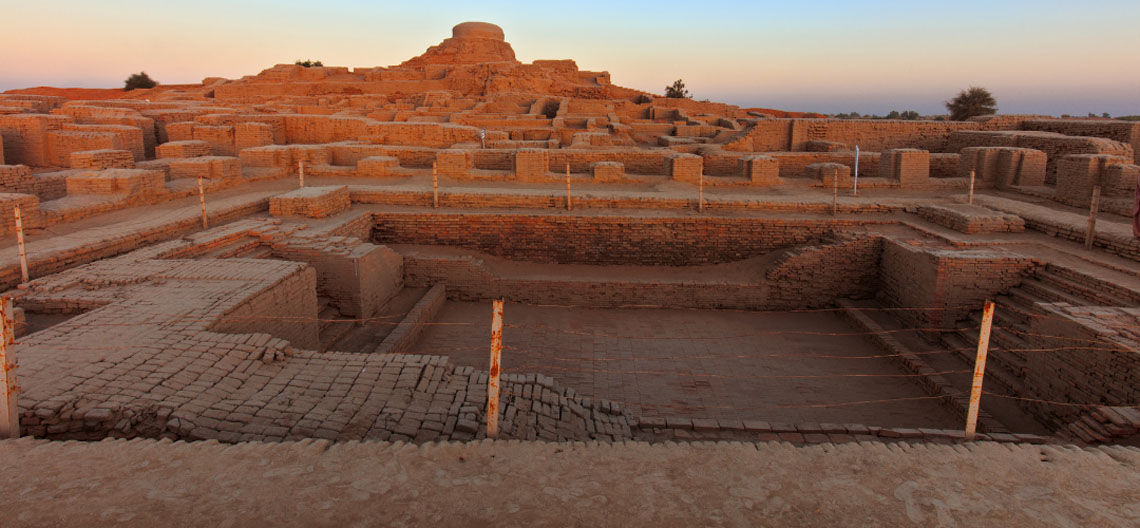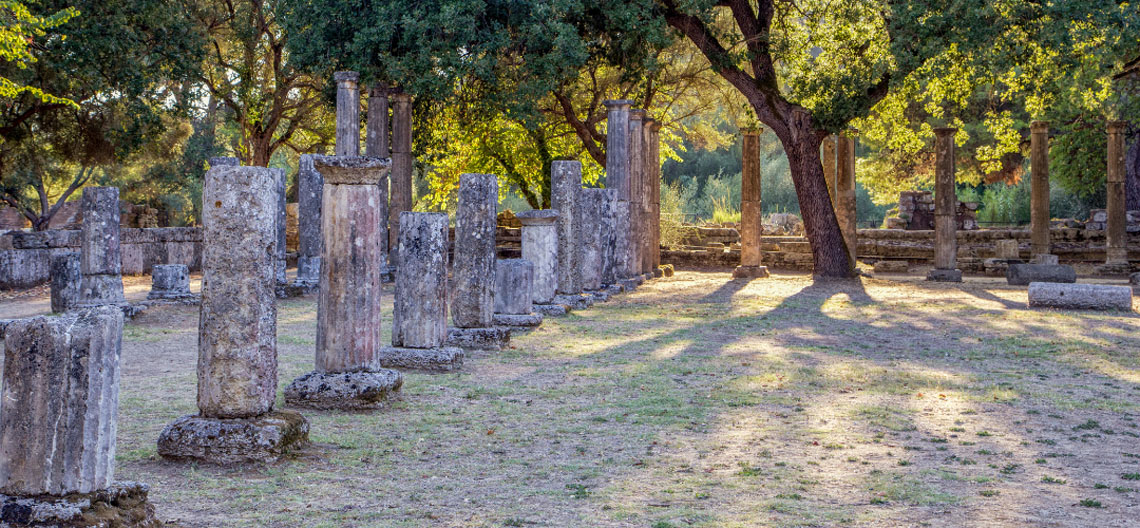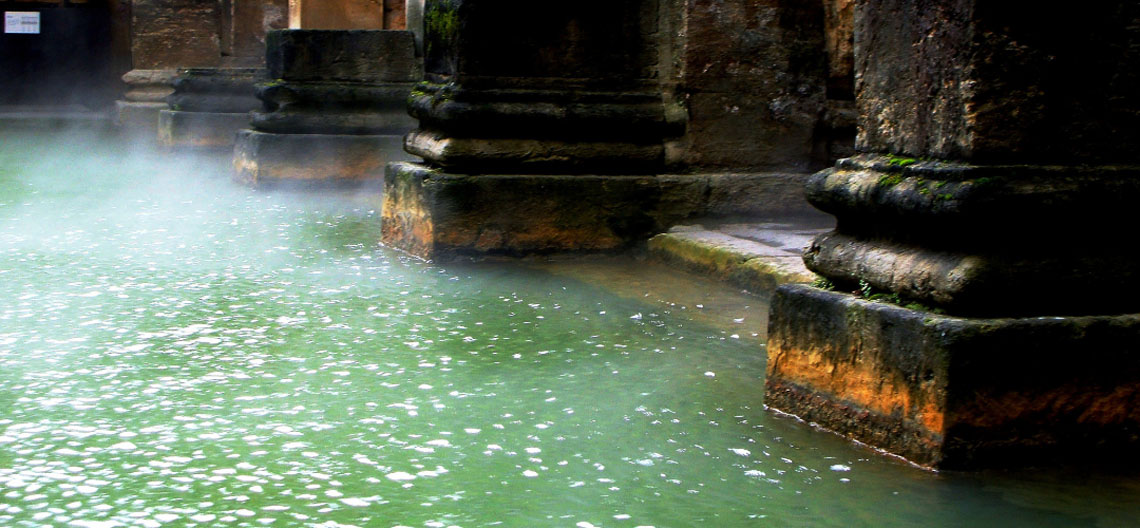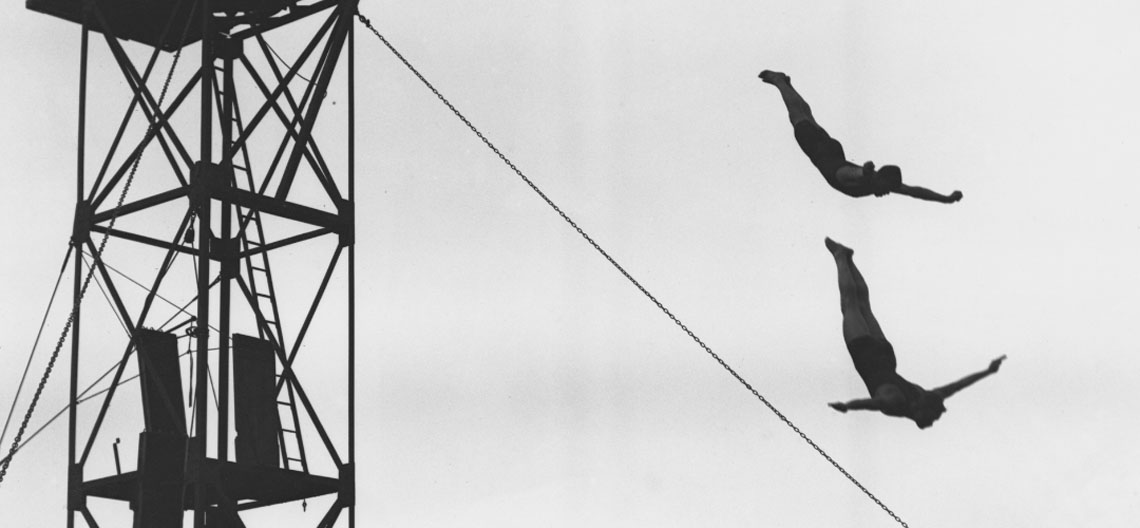
As long as humans have been near water there has been an unbreakable connection to the aquatic. Without water society could not exist or survive. The first civilizations were built near bodies of water, harnessing its power to grow crops and build society. Myths, lore and creation stories are ripe with references to water.
It’s this instinctual draw to water, its power and its benefits that led humans to create the first public bath spaces which evolved into the modern day swimming pool. Let’s explore how the swimming pool has changed since ancient times to today. Welcome to the history of the pool!
5000 B.C.: The Great Bath
The earliest public water tank called “The Great Bath” was built over 5000 years ago in the ancient Pakistani city of Mohenjo-daro. The water tank was most likely used for religious ceremonies and “ritual bathing,” not public swimming.
 The Great Bath in Mohenjo-daro at sunset. This beautiful structure was a feat of engineering for the ancient world.
The Great Bath in Mohenjo-daro at sunset. This beautiful structure was a feat of engineering for the ancient world.
2500 B.C.: Cave Swimmers
In 1993, cave paintings were discovered in Egypt that depicted figures appearing to swim. This was the first discovery of art that showed swimming in history.
800 B.C. to 600 B.C.: First recreational pools
The Ancient Greeks were the first community to create recreational swimming pools. From 800 B.C. to 600 B.C., Ancient Greece’s economy grew, freeing up more time and money to establish leisure centers or “Palaestrae,” open-air gymnasiums. Palaestrae are where swimming as a fitness and social activity took off.
 Ruins of an ancient Palaestra where a swimming pool may have been found.
Ruins of an ancient Palaestra where a swimming pool may have been found.
300 B.C. to 100 B.C.: Ancient Roman pools
The Ancient Romans built upon the Greek’s bathhouses by adding a luxurious feature to their pools and baths: heat! The first heated swimming pool was built by Gaius Maecenas, adviser to Augustus Caesar. Thermal springs and manual furnaces allowed ancient Romans to swim and bathe in warm waters.
The Romans also built aqueducts, enabling them to continuously circulate fresh water into the baths for a more sanitary and healthful experience. The largest pool built during this time period measured over 900,000 square feet.
 Steam rises from this ancient heated Roman pool.
Steam rises from this ancient heated Roman pool.
75 A.D.: Aquae Sulis
In 43 A.D. Romans conquered Britain and brought with them their practice of ritual bathing and recreational swimming. In 75 A.D. Romans built an expansive “religious spa” called Aquae Sulis which became a destination for worship, bathing, swimming and healing. Thermal springs heated Aquae Sulis, creating a pleasant water temperature to swim and worship in.
1820s: First indoor swimming pool opens to public
In 1828, swimming became more accessible when the first public indoor municipal swimming pool opened in England. The club was called St. George’s Baths and was a salt water pool.
 Indoor swimming facilities made the sport accessible to the public year-round.
Indoor swimming facilities made the sport accessible to the public year-round.
1837: Swimming takes off as a competitive sport
As interest in swimming grew, so did competitions for the sport hosted by the National Swimming Society. By the late 1830s, swimming had become a hugely popular recreational activity.
1875: Matthew Webb swims the English Channel
Captain Matthew Webb was the first recorded person to swim the English Channel, covering a distance of around 40 miles in a little over 21 hours. One of the ways Webb warded off hypothermia in the cold water was by smearing a thick layer of porpoise fat all over his body.
1900: 200m Obstacle Race at the Paris Olympics
The 1900 Paris Olympics was the first and last time the games hosted a swimming obstacle course. Competitive swimming participants swam through the Seine River, up poles, over boats and under vessels. The exciting event was unfortunately discontinued that same year.
1904: Diving enters the Olympic games
The first Olympic games that saw diving as a competitive sport were in 1904. The ten divers who participated in the first competition were from Germany and the United States.
1904 Olympic Games, World’s First Diving Competition, London
Divers fly off the platform during the 1904 Olympic Games hosted in St. Louis, MO.
 Divers fly off the platform during the 1904 Olympic Games hosted in St. Louis, MO.
Divers fly off the platform during the 1904 Olympic Games hosted in St. Louis, MO.
1906: The White star line installs a swimming pool on The Adriatic.
The pool on The Adriatic ocean liner was the first to cross the Atlantic Ocean. The ship’s pool was indoor and was also the first to be installed on an ocean liner.
1907: The first of above ground swimming pools opens at the Philadelphia Racquet Club
The Racquet Club of Philadelphia is one of the most exclusive sports clubs in North America. This amazing club boasts the first above ground pool in America, an incredible feat for this time period.
1912: Women's swimming events are added to the Olympics
For the first time at the Olympic games women were able to participate in swimming events at the 1912 Stockholm games. Women could enter either the 100m freestyle event or 400m relay race. The first winner of the 100m freestyle event was Fanny Durack from Australia. Women from the United States were not allowed to enter because of the US’ mandate that women participate in long skirts.
 The first female competitive swimmers are Australians Mina Wylie (left) and Fanny Durack (right) pictured here after winning silver and gold medals, respectively.
The first female competitive swimmers are Australians Mina Wylie (left) and Fanny Durack (right) pictured here after winning silver and gold medals, respectively.
1924: Johnny Weissmuller sets world swimming records
Johnny Weissmuller is a swimming and Hollywood icon. From setting dozens of world records that endured for years to delighting fans on the silver screen as Tarzan, Weissmuller went from one iconic role to the next.
1936: Deep Eddy Pool built in Austin, TX
The iconic Deep Eddy Pool in Austin, TX earned its name from how the pool was originally formed. The Colorado River created a swimming hole in Austin Texas where a giant boulder formed an eddy, or a pool of swirling water blocked from flowing because of a large obstacle. Today, swimmers can still enjoy the fresh water, swimming lanes and wading area of this amazing historic site.
1943: Two-piece swimsuits are introduced
Two-pieces swimsuits for women grew in popularity during the early 1940s because wartime shortages prompted a 10% reduction in the amount of fabric used to create swimsuits.
 The first bikini ever created could fit into the box in the model’s left hand.
The first bikini ever created could fit into the box in the model’s left hand.
1972: Mark Spitz wins gold at the Summer Olympics
Mark Spitz entered seven events at the 1972 Summer Olympics in Munich, Germany. Not only did he win gold in all seven events, he also beat the world record for each event. His performance rocked the world and his records endured until Michael Phelps stepped onto the Olympic circuit in 2008.
2008: Michael Phelps wins big at the Olympics
At the 2008 Beijing Olympic Games, then-18 year old Michael Phelps broke Spitz’ previously held record of 7 gold medals by earning 8 gold medals that year. His success propelled him into stardom, earning him a record-breaking total of 23 gold medals over his incredible career.
Today: The Pool and Hot Tub Alliance estimates there are more than 10 million swimming pools across the USA, including more than 300,000 public pools. The growing number of pools and hot tubs in the United States represents the need for private leisure space and emphasis on health and fitness.
 Modern medence egy lakóház kertjében
Modern medence egy lakóház kertjében

Szólj hozzá